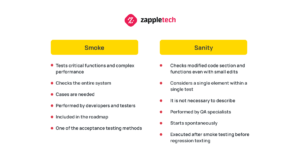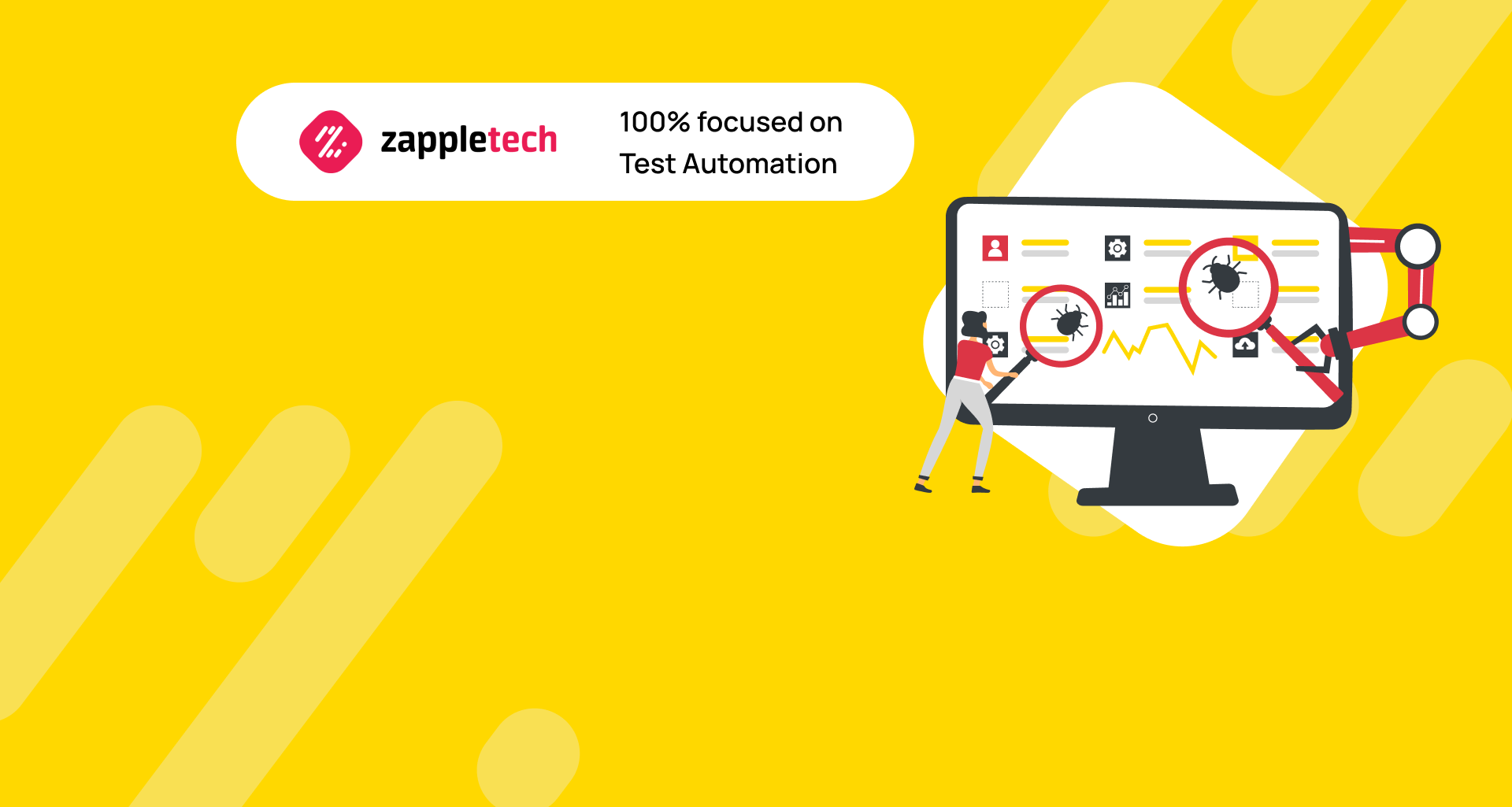
According to the GMInsights research, the value of the QA services market in 2020 exceeded $40 billion and is projected to grow by 7% annually, reaching $60 billion by 2027. This rapid growth highlights the increasing demand and critical importance of testing in the creation of modern complex systems and single products. In today’s competitive market, if a company releases the first software version containing performance or interface errors, customers are likely to respond negatively, which could severely impact the brand’s reputation and drive users to competitors. This makes it essential to ensure rigorous quality control right from the early stages of development. The cost of a mistake can be prohibitive, especially for startups, where even minor errors can lead to significant financial and reputational damage.
Given these stakes, automated sanity testing becomes a vital tool in the QA process. ZappleTech experts have thoroughly studied the QA industry and compiled detailed information on its importance and role in the viability of IT products. Their findings emphasize how automated sanity testing can effectively identify errors at all stages of application development, ensuring that products meet the high standards expected by users. From the article, you will gain deeper insights into the process of sanity testing automation and how it contributes to maintaining the reliability and performance of software projects.
Table of Contents
Automated Sanity Testing: Goals, Objectives, Blind Spots, Frequency, and Problems
Sanity testing is one of the most crucial aspects of quality assurance (QA), playing a vital role in identifying problematic areas in software that either fail to function properly or do not perform required actions. This type of testing is essential in ensuring that the basic functionality and core functionalities of an application are working as expected after minor changes or bug fixes. However, relying on spontaneous or ad-hoc approaches to sanity testing is a fundamentally flawed practice that can lead to missed issues and inadequate coverage.
The goals and objectives of sanity testing include quickly verifying that recent code changes have not adversely affected the critical functionalities of the software. By focusing on specific areas of concern, sanity testing ensures that any new defects are caught early in the development cycle, preventing them from escalating into more significant problems later on.
Despite its importance, sanity testing has its blind spots. Since it is typically a targeted and narrow scope test, it may overlook some issues that a broader testing approach might catch. Therefore, it’s essential to complement sanity testing with more comprehensive testing methods to ensure full coverage.
The frequency of sanity testing depends on the pace of development and the frequency of code changes. Ideally, it should be performed regularly, especially after every significant update or bug fix. This helps maintain a high level of software quality and reduces the risk of introducing new defects.
However, manual sanity testing can be time-consuming and prone to human error. To address this, many teams are turning to automated sanity testing. Automated sanity testing allows for quicker execution and more consistent results, ensuring that critical areas are tested thoroughly and efficiently every time changes are made.
Sanity testing is needed for:
Checking the finished build and each component.
Identification of non-working functions.
Comparison of results using the “white box” method.
Surface testing of each item.
Obtaining information about the progress of an IT product.
Defining major and minor bugs.
Automated sanity testing helps you quickly verify that recent code changes haven’t broken existing functionality, ensuring continuous stability throughout the development process. This keeps your project on track and minimizes disruptions.Mykhailo PoliarushCEO, ZappleTech Inc.
Automated sanity testing helps you quickly verify that recent code changes haven’t broken existing functionality, ensuring continuous stability throughout the development process. This keeps your project on track and minimizes disruptions.Mykhailo PoliarushCEO, ZappleTech Inc. A bit like a kind of regression testing, isn’t it? In fact, a health check is its component, although it makes sense to consider them separately, not combined in a complex.
Sanity testing tasks:
Reducing non-working functions.
Cursory check of the product at every stage.
Indication of development progress and its effectiveness.
Additional collection of information about unresolved bugs.
Spontaneous checking between sprints or during them.
Study of the main problems, analysis, and prevention.
Performance testing is provided by the “white box” method. Although limited in scope, it improves the final quality, reduces data scatter in the reports, and facilitates faster error recovery.
Definition and Purpose of Sanity Testing
Sanity testing is a type of software testing that involves verifying the functionality of a software application or system after minor changes or bug fixes. The primary purpose of sanity testing is to ensure that the changes made to the software have not introduced any new bugs or issues that could affect its overall functionality. This type of testing is a crucial step in the software development life cycle, as it helps to identify and fix defects early on, reducing the risk of downstream problems and ensuring that the software meets the required quality standards. By focusing on specific areas of concern, sanity testing provides a quick and efficient way to validate that the software remains stable and reliable after updates.
Sanity vs. smoke comparison: different approach and philosophy
Many people compare these two types of testing, which is a common mistake. While sanity testing reveals superficial problems only, smoke testing is used to scan a wide area at all stages of development. Sanity testing focuses on verifying specific functionalities after changes are made, ensuring that a known result is achieved. In contrast, smoke testing determines whether the basic functions of a software application are fully operational or if they are interrupted at some stage.
In addition to traditional sanity testing, automated sanity testing plays a crucial role in modern software development. This approach allows for faster and more consistent checks, ensuring that key functionalities work as expected after each code change. By incorporating automated sanity testing into the process, developers can quickly identify any issues, further distinguishing it from the broader scope of smoke testing.
Let’s take a look at the main differences:

This table demonstrates the difference between these types of checks. They cannot be compared because they are complementary and focus the attention of QA specialists on different areas of the product. Both tests are vital and cannot be mutually exclusive.
Goals and Objectives of Sanity Testing
The primary goals and objectives of sanity testing are to:
Verify that the changes made to the software have not introduced any new bugs or issues.
Ensure that the software functions as expected after minor changes or bug fixes.
Identify and fix defects early on, reducing the risk of downstream problems.
Build confidence in the software, allowing developers to move forward with further testing and deployment.
Reduce the overall cost of software development by identifying and fixing defects early on.
By achieving these goals, sanity testing helps maintain the integrity and quality of the software throughout the development process.
Frequency of automated sanity testing of an IT product
Automated sanity testing plays a crucial role in maintaining the stability of an IT product during its development cycle. The frequency of automated tests, including automated sanity testing, can significantly impact the overall efficiency and quality of the project. The more often it is conducted, the better it ensures that the core functionalities of the software remain intact after minor changes or bug fixes.
It’s advisable to start preparing for automated sanity testing from the project’s inception, but its true effectiveness becomes apparent after the first builds are compiled. If builds are compiled daily, the frequency of these tests should match to ensure that any issues are caught early. However, it’s essential to balance this with productivity, as each testing cycle can take around 20 minutes.
Although automated sanity testing is essential, it’s often performed as a secondary process. This is because other testing types, such as regression or functional testing, are prioritized for their deeper analysis of the product. Automated sanity testing, however, addresses the need for quick validation of key features, ensuring that the product remains stable even as development progresses. We’ll delve into how this process works and its benefits in detail later.
By automating sanity tests, you can rapidly assess core features without manual intervention, saving valuable time and resources. This allows your team to focus on more complex testing tasks, increasing overall efficiency.Sergey AlmyashevCOO, ZappleTech Inc.
When to Perform Sanity Testing?
Sanity testing should be performed after minor changes or bug fixes have been made to the software. This can include:
After a new build has been released.
After bug fixes have been implemented.
After minor changes have been made to the software.
Before further testing and deployment.
By conducting sanity testing at these critical junctures, developers can ensure that the software remains stable and functional, paving the way for more comprehensive testing and successful deployment.
Blind spots and regression testing issues:
So, testing starts only after compiling a working build, which is the main problem of this solution. Unlike the others, performance checking is about looking for deviations between the actual and expected results. The intermediate state of an IT product is a blind spot that neutralizes attempts to investigate the functionality for errors. This blind spot often complicates the identification of issues that could have been caught earlier in the development cycle, making it crucial to incorporate automated sanity testing to continuously monitor and verify core functionalities even during these intermediate stages.
The second problem with performance testing is superficiality. You cannot set more advanced parameters for the scenario, only the expectation/reality comparison. Actually, it is not a critical disadvantage because the test is a component of regression testing performed to get additional information about the product during sprints and spontaneous checks. However, integrating automated sanity testing within this process can help address this issue by providing consistent, automated checks that ensure the system’s critical functions remain stable, even with the introduction of new code.
Sanity vs. smoke comparison: different approach and philosophy
Many people compare these two types of testing, which is a common mistake. While sanity testing reveals superficial problems only, a smoke test is used to scan a wide area at all stages of development. Sanity testing focuses on verifying specific functionalities after changes are made, ensuring that a known result is achieved. In contrast, smoke tests determine whether the basic functions of a software application are fully operational or if they are interrupted at some stage.
In addition to traditional sanity testing, automated sanity testing plays a crucial role in modern software development. This approach allows for faster and more consistent checks, ensuring that key functionalities work as expected after each code change. By incorporating automated sanity testing into the process, developers can quickly identify any issues, further distinguishing it from the broader scope of smoke testing.
Let’s take a look at the main differences:
This table demonstrates the difference between these types of checks. They cannot be compared because they are complementary and focus the attention of QA specialists on different areas of the product. Both tests are vital and cannot be mutually exclusive.

An example of using Sanity during testing
Imagine a marketplace project where multiple sellers operate, each paying a commission to the platform’s owner for every transaction. For instance, the platform might take a 10% commission on sales, plus an additional 1% for processing fees when payments are made using a bank card. One critical aspect to check is whether these commissions are calculated automatically and correctly transferred to the owner’s account.
Let’s break this down with a specific example. We start with a transaction amount of $350 and use two virtual cards: one for the seller and one for the intermediary. After processing the transaction, we check the balances. If the seller ends up with $311.5 and the intermediary with $38.5, we consider the test successful, and the results are accurate. However, if the expected amounts don’t match, this indicates a potential bug in the system, and further testing is required. The issue is then flagged and assigned to developers to be fixed.
While this type of testing is essential, repeating it manually every day can quickly become tedious for a specialist, leading to delays or even neglect of the task. This is where automated sanity testing comes into play. By automating this process and incorporating it into regular sprints, you can ensure that these checks are performed consistently without the risk of human error or oversight.
Incorporating automated sanity testing into your testing strategy not only saves time but also enhances the reliability of your marketplace platform, ensuring that financial transactions are always processed accurately and efficiently.
Automated sanity tests: advantages, tools, profit
Automated sanity testing plays a crucial role in ensuring the stability and reliability of software products. By employing automated tests to automate the processes that are typically performed manually and spontaneously, you can significantly enhance the efficiency of testing and reduce the likelihood of human error. This type of testing focuses on verifying that new changes or updates to the codebase do not introduce any unforeseen issues or bugs. It’s particularly beneficial after minor code modifications, where a quick validation is necessary to ensure that everything still functions as expected.
One of the primary advantages of automated sanity testing is the speed at which tests can be executed. Automated tools can run these tests much faster than a human could, allowing for more frequent testing and quicker feedback. This is especially important in agile development environments, where code changes are frequent, and the need for rapid testing is paramount.
Moreover, automated sanity testing tools can be integrated into your continuous integration and continuous deployment (CI/CD) pipelines, further streamlining the development process. By catching issues early in the development cycle, you can avoid costly delays and ensure that your product meets the highest quality standards before it reaches the end users.
In addition to improving testing efficiency, automated sanity testing also contributes to overall cost savings. By reducing the need for manual testing, you can allocate resources more effectively and focus on more complex testing scenarios that require human insight. This not only saves time but also increases the overall profitability of your project by ensuring that your software is reliable and ready for release.
In conclusion, incorporating automated sanity testing into your QA strategy is essential for maintaining the stability and quality of your software products. The advantages it offers, from faster testing cycles to cost savings, make it an indispensable tool in modern software development. By automating sanity tests, you can rapidly assess core features without manual intervention, saving valuable time and resources. This allows your team to focus on more complex testing tasks, increasing overall efficiency.
Sergey Almyashev COO, ZappleTech Inc.
Sanity testing automation has many advantages over traditional manual error checking:
It speeds up checking and comparing the expected result with the actual one.
Testing is parallelized, so it is possible to run multiple scripts for different functions simultaneously.
There is no need for strict control over checking each element.
More time to concentrate on more important and urgent tasks.
Decreased reliance on regression testing between sprints due to continuous troubleshooting.
The final quality of testing and its effectiveness are improved in terms of stability and the number of fixes before release.
To optimize the development and QA service, you need to run automated sanity testing during sprints, starting from the early stages of project development.
Do the implementation team and the customer benefit from sanity testing automation? What do you think?
Automated sanity tests provide immediate feedback after code changes, enabling faster detection of critical issues. This helps in addressing problems early, reducing the risk of larger defects down the line.Mikhail BodnarchukCDO, ZappleTech Inc.
Tools to optimize the sanity check process
To optimize the sanity check process, it’s crucial to consider tools that are specifically designed to enhance efficiency and accuracy through automated tests. Given the limited testing area involved in sanity checks, almost any basic automation tool can be effective, provided it works seamlessly with the interface, handles input/output data efficiently, and accurately analyzes the results. When selecting a tool, ensure that it aligns with your technical stack, product type, and specific features.
In our projects, we emphasize the use of classic software and automation environments that have consistently demonstrated flexibility, versatility, and reliability. This approach not only streamlines the process but also integrates automated sanity testing into the workflow, ensuring that the software maintains stability and meets quality standards before moving forward in the development cycle.
Best tools for sanity testing automation:
Selenium is one of the most popular products for automating interface and functionality testing. Works with a wide range of technologies and supports scripting.
Cypress is a widespread test automation tool. It supports algorithm-based customized scenarios and has a recording/playback feature, which makes it versatile for testing web solutions.
Playwright is a good cross-platform alternative to other web product testing apps. It supports extended syntax, all popular browsers, and many programming languages.
Let’s summarize the software development life cycle
Many people believe that automated tests in sanity testing automation are merely a subset of regression testing and, as such, aren’t necessary as a separate process. However, we strongly disagree. Our team considers automated sanity testing to be a crucial step in the QA process, offering an extra layer of validation that ensures your product’s core functionality is intact after any changes. This proactive approach allows us to catch and address issues early, reducing the likelihood of more significant problems arising later in the development cycle.
Automated sanity testing serves as a quick, efficient check that saves time and resources, ultimately contributing to a smoother and more reliable product launch. By integrating this process into your QA strategy, we can help you deliver a higher-quality product that meets customer expectations and performs flawlessly under real-world conditions.
Automated sanity tests provide immediate feedback after code changes, enabling faster detection of critical issues. This helps in addressing problems early, reducing the risk of larger defects down the line. Mikhail Bodnarchuk CDO, ZappleTech Inc.
Need to test an IT product? Order this service from our manager, and we will provide you with quality services that will speed up your product’s release, ensuring a quicker path to market success and a more substantial return on investment. Whether you’re working on a small update or a major release, our automated sanity testing service will help you achieve your goals with confidence and precision.






